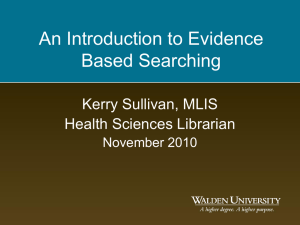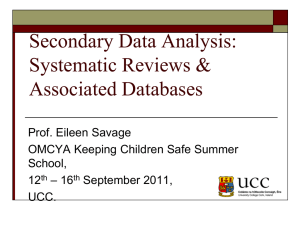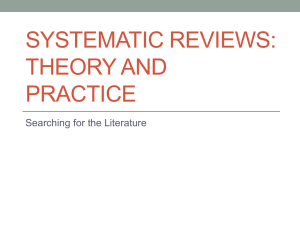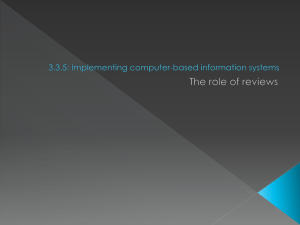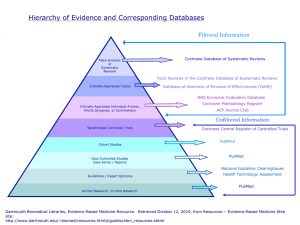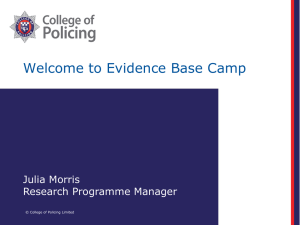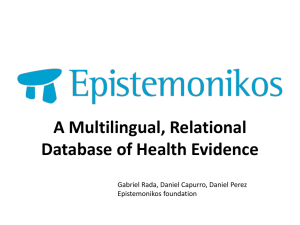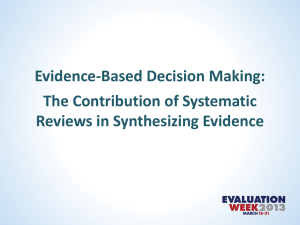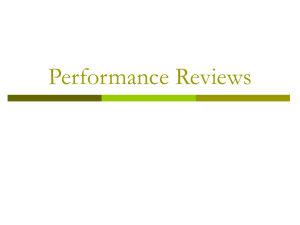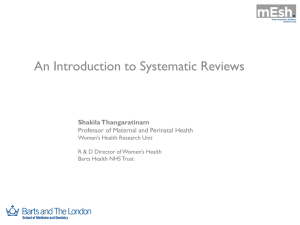Session Slides - Ebling Library
advertisement
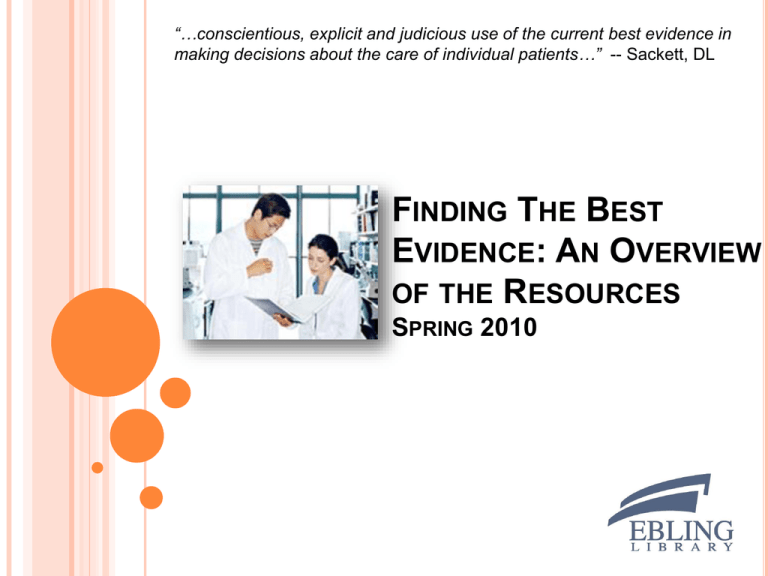
“…conscientious, explicit and judicious use of the current best evidence in making decisions about the care of individual patients…” -- Sackett, DL FINDING THE BEST EVIDENCE: AN OVERVIEW OF THE RESOURCES SPRING 2010 THIS SESSION WILL COVER What do we mean by evidence-based health care Steps in practicing evidence-based care Types of literature Key resources for finding evidence-based information 2 THREE PRONGED APPROACH The Patient Patient’s characteristics & values EBP! Best Evidence Clinically relevant research, the literature Clinical Expertise Practitioner’s knowledge & experience 3 3 WHY USE AN EVIDENCE-BASED APPROACH? Need for current clinical information Updates info in textbooks, journals, experts Skills/experiences increase over time, current knowledge may decrease Increase in clinical research and literature Conflicting clinical research [at times] Limited time to find and evaluate research 4 STEPS IN PRACTICING EBP 1. 2. 3. 4. 5. Convert need for information into focused clinical question Track down the best evidence Critically appraise the evidence Integrate evidence with clinical expertise and patient values Evaluate the process and adjust as needed Evidence-based Medicine: How to Practice and Teach EBM By Straus SE, et al Third Edition. Churchill Livingstone: Edinburgh, 2005 0-443-07444-5, 299 pages. Includes CD-ROM 5 Photo from CDC: Childhood overweight CLINICAL SCENARIO Your patient is a 14-yr old boy with a weight problem (obesity). He has tried lifestyle changes and they have not been effective, so he and his parents ask you about other weight loss options for an adolescent. 6 USING THE LITERATURE IN PRACTICE Background vs. Foreground questions Background questions – getting up to speed on a topic. General knowledge about a disorder. Look for info in textbooks, summary material. Foreground questions – specific knowledge about managing a patient or disorder. Apply EBP techniques, use EBP resources 7 7 BACKGROUND SOURCES UpToDate Clinical Evidence MDConsult STAT!Ref MICROMEDEX Specialty texts via Ebling Library website Harrisons 8 EVIDENCE-BASED CLINICAL SUMMARY Medical topics in internal medicine (particularly strong), pediatrics, ob/gyn and family medicine Designed to provide a quick way to get up to speed An updated version of UpToDate is released every four months “What’s New” tab highlight changes with each major release. For use in EBM is a mixed bag (use cautiously to answer clinical questions (i.e. PICO questions) Articles are a mixture of medical conclusions based on data from studies and expert opinions of individual authors…not always clear which statements are evidence-based and which are not 9 9 USING THE LITERATURE IN PRACTICE Background vs. Foreground questions Background questions – general knowledge about a disorder. Look for info in Reference sources Foreground questions – specific knowledge about managing a patient or disorder. Apply EBP techniques, use EBP resources In a 14 year old obese male, how effective is the drug Meridia for long term weight loss? 10 1 0 CONVERT THE CLINICAL QUESTION TO PICO P I C O helps to formulate the question Patient/Population/Problem Intervention Comparison Outcome 11 CONVERT THE CLINICAL QUESTION TO PICO P I In a 14 year old obese male, how effective is the drug Meridia for long term weight loss? O C – no comparison/placebo 12 CREATING A SEARCH QUERY P = In a 14 yo obese male I = is Meridia C= O = effective and safe for long term weight loss? P obese obesity overweight adolescent adolescence teen teenager youth I Meridia sibutramine 13 CREATING A SEARCH QUERY P = In a 14 yo obese male I = is Meridia P obese obesity overweight I adolescent adolescence teen teenager youth Meridia sibutramine ORANGE = MeSH term 14 CREATING A SEARCH QUERY (adolescent OR adolescence OR teen OR teenager OR youth OR child ) AND (obese OR obesity OR overweight ) AND (meridia OR sibutramine) Place an “OR” between synonyms of the same concept and surround concept terms with parentheses Place an “AND” between concepts 15 15 CREATING A SEARCH QUERY (adolescent OR adolescence OR teen OR teenager OR youth OR child) AND (obesity OR obese OR overweight) AND (meridia OR sibutramine) Use truncation character, if available: (adolescen* OR teen* OR youth OR child) AND (obes* OR overweight) AND (meridia OR sibutramine) 16 16 STEPS IN PRACTICING EBP 1. 2. 3. 4. 5. Convert need for information into focused clinical question Track down the best evidence Critically appraise the evidence Integrate evidence with clinical expertise and patient values Evaluate the process and adjust as needed 17 EVIDENCE HIERARCHY high Randomized control trials (RCTs) Prospective cohort studies Case-control (retrospective cohort) studies Case studies Opinion of authorities, editorials Level of Evidence Clinical summaries Meta analyses/Systematic reviews low 18 EVIDENCE-BASED CLINICAL SUMMARY A compendium of short summaries of the current state of the knowledge (and uncertainty) about clinical conditions (prevention, treatment, and/or diagnosis) Entries are explicitly based on thorough searches and appraisals of the literature and created from the best available evidence from systematic reviews, RCTs and observational studies 19 EVIDENCE-BASED CLINICAL SUMMARIES Examples: BMJ Clinical Evidence Essential Evidence Plus UpToDate http://clinicalevidence.bmj.com/ http://www.essentialevidence.com/ http://www.uptodate.com 20 EVIDENCE-BASED CLINICAL SUMMARY Collection of brief reviews focusing on primary care and covering over 3,000 clinical interventions with 570 clinical questions answered. Looks at current state of knowledge & ignorance about prevention and treatment. Describes the best available evidence and if there is no good evidence, it says so. Each review focuses on single condition and is displayed in a tabbed structure: • • • • • Single page summary of the review Ranked list of interventions with discussion (benefits/harms) Background info on the condition A list of material published since the review search date Links to major guidelines relevant to the review 21 21 EVIDENCE HIERARCHY high Randomized control trials (RCTs) Prospective cohort studies Case-control (retrospective cohort) studies Case studies Opinion of authorities, editorials Level of Evidence Clinical summaries Meta analyses/Systematic reviews low 22 SYSTEMATIC REVIEWS Summarize a particular topic by using explicit methods to perform a thorough literature search and critical appraisal of individual studies to identify the valid and applicable evidence Uses appropriate techniques to combine these valid studies Published in many journals and found in a variety of other electronic sources 23 SYSTEMATIC REVIEWS Examples: Cochrane Database of Systematic Reviews DARE TRIP Database MEDLINE (PubMed) http://www.cochrane.org/ http://www.crd.york.ac.uk/crdweb/ http://www.tripdatabase.com http://www.pubmed.gov 24 SYSTEMATIC REVIEWS 5,600 systematic reviews and meta-analyses Rigorous, highly-regarded, reviews Focused on therapy/prevention, now covering diagnostic tests Database includes protocols -- plans or sets of steps to be followed in creating a systematic review When searching within the Cochrane Library: use the “Title, Abstract, Keywords” drop down to reduce irrelevant records Contains 15,000 reviews of systematic reviews. Complements the CDSR -- quality-assesses and summarizes reviews that have not yet been carried out by Cochrane When searching within the Cochrane Library: use the “The full review (Search All Text)” drop down to reduce irrelevant records 25 25 SYSTEMATIC REVIEWS Often overlooked secondary source for evidence on any type of foreground question Reviews the best original and review articles from over 100 of the top clinical journals If included, it is important! Unlike DARE, clinical experts provide commentaries on the context, methods, and clinical applications of the findings of each article New interface Includes only records/abstracts of journal articles (20 million) Very current info (sometimes pre-pub) Use MeSH terms for more efficient searching Use Boolean operators (AND, OR) Searching for systematic reviews: • Use the “Find Systematic Reviews” box in Clinical Queries OR Apply the Subsets limit “Systematic Reviews” 26 26 SYSTEMATIC REVIEWS 15,000 # published per year 12,500 10,000 7500 5000 2500 1990 1995 2000 2005 2010 27 SYSTEMATIC REVIEWS Many conditions, interventions, diagnostic tools without good SRs Need constant maintenance. Half will need to be updated each year Garbage in; garbage out FAAT handout http://www.cebm.net/index.aspx?o=1157 28 28 EVIDENCE HIERARCHY high Randomized control trials (RCTs) Prospective cohort studies Case-control (retrospective cohort) studies Case studies Opinion of authorities, editorials Level of Evidence Studies Clinical summaries Meta analyses/Systematic reviews low 29 INDIVIDUAL STUDIES Examples: MEDLINE (PubMed) http://www.pubmed.gov Google Scholar http://scholar.google.com Other health databases CINAHL http://www.cinahl.com/ PsycINFO http://www.apa.org/psycinfo/ 30 INDIVIDUAL STUDIES Includes only records/abstracts of journal articles (20 million) Very current info (sometimes pre-pub) Use MeSH terms for more efficient searching Use Boolean operators (AND, OR) Searching for single studies: • Use the “Search by Clinical Study Category” box in CQ • OR use the type of article limit: randomized controlled trials or other appropriate level Subset of larger Google: journal articles, technical reports, preprints, theses, books and other documents and web pages deemed “scholarly” Covers a great range of disciplines (strong in sciences and medicine) It is particularly helpful for users who want: • something good enough for the task at hand (not comprehensive) • grey literature--sources outside of published journals • info from sources across many disciplines Limitations: rudimentary search features, lack of transparency of database 31 content, uneven coverage (time and scope) and a delay in indexing 31 GENERAL SEARCH HINTS Identify synonyms OR between synonyms Check MeSH database via PubMed Use generic and trade names for drugs and tests Use full names along with common abbreviations OR between synonyms Surround OR terms with parentheses Enter concepts as separate sets AND between P, I,C common cold AND (vitamin c OR ascorbic acid) 32 STEPS IN PRACTICING EBP 1. 2. 3. 4. 5. Converting need for information into focused clinical question Tracking down the best evidence Critically appraising the evidence Integrating evidence with clinical expertise and patient values Evaluating the process 33 CRITICALLY APPRAISING THE EVIDENCE Centre for EBM (Toronto) http://www.cebm.utoronto.ca Centre for EBM (Oxford) http://www.cebm.net Users’ Guides series in JAMA http://www.userguides.org 34 34 Statistics Toolkit By Perera R, et al BMJ Books 2008 ISBN: 978-1-4051-6142-8 120 pages 35 STEPS IN PRACTICING EBP 1. 2. 3. 4. 5. Converting need for information into focused clinical question Tracking down the best evidence Critically appraising the evidence Integrating evidence with clinical expertise and patient values Evaluating the process 36
